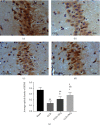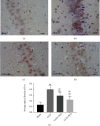Effects of Ozone on Hippocampus BDNF and Fos Expressions in Rats with Chronic Compression of Dorsal Root Ganglia
- PMID: 34869766
- PMCID: PMC8642004
- DOI: 10.1155/2021/5572915
Effects of Ozone on Hippocampus BDNF and Fos Expressions in Rats with Chronic Compression of Dorsal Root Ganglia
Retraction in
-
Retracted: Effects of Ozone on Hippocampus BDNF and Fos Expressions in Rats with Chronic Compression of Dorsal Root Ganglia.Biomed Res Int. 2024 Mar 20;2024:9821958. doi: 10.1155/2024/9821958. eCollection 2024. Biomed Res Int. 2024. PMID: 38549992 Free PMC article.
Abstract
The effects of ozone on hippocampal expression levels of brain-derived neurotrophic factor (BDNF) and c-fos protein (Fos) were evaluated in rats with chronic compression of dorsal root ganglia (CCD). Forty-eight adult female Sprague-Dawley rats were randomly divided into the following 4 groups (n = 12): sham operation (sham group), CCD group, CCD with 20 μg/ml of ozone (CCD + AO3 group), and CCD with 40 μg/ml of ozone (CCD + BO3 group). Except the sham group, unilateral L5 dorsal root ganglion (DRG) compression was performed on all other groups. On days 1, 2, and 4 after the operation, the CCD + AO3 and CCD + BO3 groups were injected with 100 μl of ozone with concentrations of 20 and 40 μg/ml, respectively. Thermal withdrawal latencies (TWLs) and mechanical withdrawal thresholds (MWTs) were measured at various time points before and after the operation. BDNF and Fos expressions were examined in the extracted hippocampi using immunohistochemistry. The TWLs and MWTs of CCD model rats that received ozone were lower with decreased BDNF and increased Fos expression levels, on day 21 after the operation, compared to those of the sham group (P < 0.05). The TWLs and MWTs of the CCD + AO3 and CCD + BO3 groups were higher with increased BDNF and decreased Fos expression levels, on day 21 after the operation, compared to those of the CCD group (P < 0.05). The TWLs were longer and the MWTs were higher in the CCD + BO3 group at each time point with increased BDNF and decreased Fos expression levels, on day 21 after the operation, compared to those of the CCD + AO3 group (P < 0.05). Our results revealed that ozone can relieve the neuropathic pain caused by the pathological neuralgia resulting from DRG compression in rats. The mechanism of action for ozone is likely associated with changes in BDNF and Fos expression levels in the hippocampus.
Copyright © 2021 Lingling Zhu et al.
Conflict of interest statement
All authors declare no conflicts of interest.
Figures





Similar articles
-
[Analgesic effect and mechanism of electroacupuncture on SNI rats based on microglia-BDNF-neuron signal].Zhongguo Zhen Jiu. 2022 Sep 12;42(9):1029-36. doi: 10.13703/j.0255-2930.20210617-0004. Zhongguo Zhen Jiu. 2022. PMID: 36075600 Chinese.
-
[Effects of curcumin on behavior and p-ERK, p-CREB, c-fos expression in dorsal root ganglion in chronic constrictive injury rats].Zhongguo Ying Yong Sheng Li Xue Za Zhi. 2009 Aug;25(3):418-22. Zhongguo Ying Yong Sheng Li Xue Za Zhi. 2009. PMID: 21155252 Chinese.
-
Pregabalin alters nociceptive behavior and expression level of P2X3 receptor in the spinal dorsal horn in a rat model induced by chronic compression of the dorsal root ganglion.Anat Rec (Hoboken). 2013 Dec;296(12):1907-12. doi: 10.1002/ar.22816. Epub 2013 Oct 17. Anat Rec (Hoboken). 2013. PMID: 24136739
-
Redox Imbalance in the Peripheral Mechanism Underlying the Mirror-Image Neuropathic Pain Due to Chronic Compression of Dorsal Root Ganglion.Neurochem Res. 2016 May;41(5):958-64. doi: 10.1007/s11064-015-1724-9. Epub 2015 Oct 15. Neurochem Res. 2016. PMID: 26471165
-
Brain-derived neurotrophic factor redistribution in the dorsal root ganglia correlates with neuropathic pain inhibition after resiniferatoxin treatment.Spine J. 2010 Aug;10(8):715-20. doi: 10.1016/j.spinee.2010.03.029. Epub 2010 May 7. Spine J. 2010. PMID: 20452292
Cited by
-
Retracted: Effects of Ozone on Hippocampus BDNF and Fos Expressions in Rats with Chronic Compression of Dorsal Root Ganglia.Biomed Res Int. 2024 Mar 20;2024:9821958. doi: 10.1155/2024/9821958. eCollection 2024. Biomed Res Int. 2024. PMID: 38549992 Free PMC article.
-
Acute Ozone-Induced Transcriptional Changes in Markers of Oxidative Stress and Glucocorticoid Signaling in the Rat Hippocampus and Hypothalamus Are Sex-Specific.Int J Mol Sci. 2023 Mar 29;24(7):6404. doi: 10.3390/ijms24076404. Int J Mol Sci. 2023. PMID: 37047376 Free PMC article.
-
Time dependent changes in protein expression induced by intermittent theta burst stimulation in a cell line.Front Neurol. 2024 Oct 28;15:1396776. doi: 10.3389/fneur.2024.1396776. eCollection 2024. Front Neurol. 2024. PMID: 39529622 Free PMC article.
References
Publication types
MeSH terms
Substances
LinkOut - more resources
Full Text Sources
Medical

